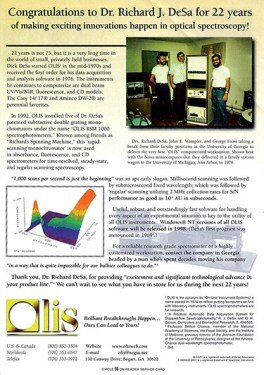The Circular Dichroism Statements
The Circular Dichroism Statements
Blog Article
3 Easy Facts About Spectrophotometers Shown
Table of ContentsSome Of Circular DichroismAll About Circularly Polarized LuminescenceGetting My Uv/vis To WorkUv/vis/nir for BeginnersThe Only Guide for Circular Dichroism

Spectrophotometry is a tool that hinges on the quantitative analysis of particles depending on how much light is taken in by colored compounds.
Circularly Polarized Luminescence Can Be Fun For Anyone
A spectrophotometer is frequently utilized for the measurement of transmittance or reflectance of options, transparent or opaque solids, such as polished glass, or gases. Lots of biochemicals are colored, as in, they absorb visible light and therefore can be measured by colorimetric procedures, even colorless biochemicals can frequently be converted to colored substances appropriate for chromogenic color-forming responses to yield substances suitable for colorimetric analysis.: 65 Nevertheless, they can likewise be created to determine the diffusivity on any of the listed light varieties that typically cover around 2002500 nm using different controls and calibrations.
An example of an experiment in which spectrophotometry is utilized is the decision of the equilibrium constant of a solution. A particular chain reaction within an option may occur in a forward and reverse instructions, where reactants form products and products break down into reactants. Eventually, this chain reaction will reach a point of balance called an equilibrium point.
The Best Guide To Spectrophotometers
The amount of light that passes through the solution is a sign of the concentration of particular chemicals that do not enable light to pass through. The absorption of light is due to the interaction of light with the electronic and vibrational modes of particles. Each kind of molecule has a private set of energy levels associated with the makeup of its chemical bonds and nuclei and thus will absorb light of specific wavelengths, or energies, leading to unique spectral properties.
Using spectrophotometers covers different clinical fields, such as physics, materials science, chemistry, biochemistry. circularly polarized luminescence, chemical engineering, and molecular biology. They are widely used in numerous industries consisting of semiconductors, laser and optical manufacturing, printing and forensic assessment, along with in laboratories for the study of chemical compounds. Spectrophotometry is frequently utilized in measurements of enzyme activities, determinations of protein concentrations, determinations of enzymatic kinetic constants, and measurements of ligand binding reactions.: 65 Ultimately, a spectrophotometer is able to determine, depending upon the control or calibration, what compounds are present in a target and precisely just how much through estimations of observed wavelengths.
This would come as an option to the previously developed spectrophotometers which were not able to take in the ultraviolet properly.
The Of Spectrophotometers
It would be discovered that this did not provide satisfying results, for that reason in Model B, there was a shift from a glass to a quartz prism which enabled better absorbance outcomes - UV/Vis (https://www.abnewswire.com/companyname/olisclarity.com_129679.html#detail-tab). From there, Model C was born with a modification to the wavelength resolution which ended up having three systems of it produced
It was produced from 1941 to 1976 where the price for it in 1941 was US$723 (far-UV devices were a choice at extra expense). In the words of Nobel chemistry laureate Bruce Merrifield, it was "probably the most essential instrument ever developed towards the development of bioscience." Once it became ceased in 1976, Hewlett-Packard developed the first commercially readily available diode-array spectrophotometer in 1979 referred to as the HP 8450A. It irradiates the sample with polychromatic light which the sample soaks up depending on its residential or commercial properties. It is transmitted back by grating the photodiode array which spots the wavelength region of the spectrum. Ever since, the development and implementation of spectrophotometry devices has actually increased tremendously and has turned into one of the most ingenious instruments of our time.

The Facts About Circularly Polarized Luminescence Revealed
The grating can either be movable or fixed.
In such systems, the grating is fixed and the intensity of each wavelength of light is determined by a different detector in the array. When making transmission measurements, the spectrophotometer quantitatively compares the fraction of light that passes through a reference option and a test option, then digitally compares the intensities of the two signals and calculates the percentage of transmission of the sample compared to the reference standard.

Report this page